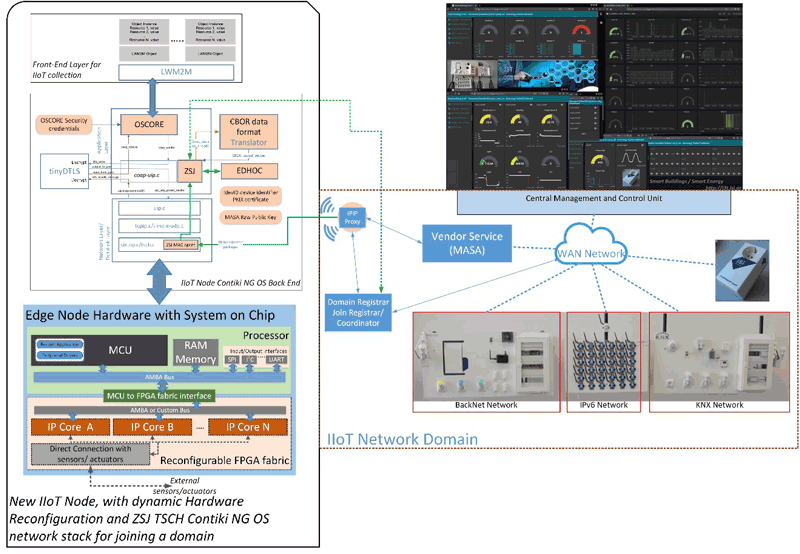by Apostolos P. Fournaris and Christos Koulamas (ISI/Research Center ATHENA)
The application of Industrial Internet of Things (IIoT) technologies in large scale and complex cyber-physical systems of systems (CPSoS), such as those on large, tertiary sector buildings, energy grid and industrial production lines, still presents great challenges in the standardisation of the necessary mechanisms, procedures, components and tools for the deployment, configuration, commissioning and maintenance of their associated highly heterogeneous distributed subsystems. The problem is magnified if one also considers the typical, resource constrained nature of most of the networked embedded devices in a CPSoS, as well as the usually strict requirements in properties related to correct and safe operations, such as real-time, reliable and secure processing and net working [2].
In contrast to more restrained environments, e.g. modern smart home automation applications, in medium and large-scale installations, the costs of manual device configuration or substitution and reinstallation can easily reach unacceptable figures. Examples of such a scenario can be, the typical deployment procedures to be followed in a smart energy meter installation within a building where centralized IT infrastructure may not yet exist and for which different engineering teams may be responsible for different phases of the installation.
In I3T, “Innovative Application of Industrial Internet of Things (IIoT) in Smart Environments” project, several objectives and activities aim at the simplification of the aforementioned procedures by the design and implementation of the necessary components and tools for the deployment, configuration and management of the industrial wireless networked embedded systems existing at the base of the IIoT technologies ecosystem. We utilise the latest developments in IETF standardisation activities around the “thin-waist” of the IoT, being the IPv6-over-X/RPL/UDP/ DTLS/CoAP related RFCs, and mainly the results of the 6TiSCH and ACE WGs as well as the latest development in embedded system on chip devices (SoC) that consist of embedded processors and on chip FPGA fabric. The activities involve the study of the highest achievable degree of the automatic initialisation and reconfiguration for different application scenarios, by identifying the different sets of parameters that need to be set off-line or on-line, and the limits between sets of parameters initialised statically at device implementation, dynamically during the deployment / commissioning time, or dynamically during the normal system operation and the whole system’s lifetime. Reconfigurability is also extended on the hardware level, where computationally demanding operations are implemented as hardware components that are dynamically allocated on the FPGA fabric of modern cyber-physical system embedded processors.
The I3T architecture is associated with the network and end nodes of an IIoT infrastructure. We adopt industrial networks that use the TSCH operation of IEEE 802.15.4e and structure on top of it, a variation of the Zero-Touch Secure Join protocol [1] that enables the secure deployment of a new node in an IIoT network without user intervention. We further enhance this mechanism so that it can perform reconfiguration of the TSCH-6Top scheduling functions using secure CoAP messages. In parallel to that, we introduce a hardware/software co-design mechanism inside each IIoT end node SoC so that each device can support dynamic reconfiguration of its hardware resources. More specifically, the designer has available a series of hardware IP cores (with associated software drivers) that can be dynamically deployed after an application functionality analysis on the IIoT device. The analysis can highlight the computationally demanding operations that need to be accelerated by hardware in order to retain the IIoT real-time responsiveness and safety requirements. Target examples for hardware acceleration can be security/cryptographic primitive operations, and machine learning processing on fast and large time series data from the monitoring of electrical grid critical parameters or from machine and structural elements vibration sensors [3].
As an outcome of the above activities, we created an integrated, medium scale demonstrator for the smart energy and smart building environment, which includes widely used, wired and wireless, heterogeneous technologies of the relevant domains (e.g. BACNet, KNX, etc) which can also be attached to virtual environment simulators, in a hardware-in-the-loop fashion, capable of demonstrating the system operation at a larger scale. We have also designed and developed an IIoT node prototype that can support the I3T dynamic hardware accelerated reconfiguration and handle the TSCH software network stack (with all the proposed dynamic, zero touch secure I3T enhancements) [3].

Figure 1: Heterogeneous IIoT technologies in reconfigurable Smart Building and Smart Energy environments.
Link:
[L1] https://i3t.isi.gr
References:
[1] M. Richardson: “6tisch Zero-Touch Secure Join protocol,” Internet Engineering Task Force Draft
[2] C. Koulamas et al.: “IoT components for secure smart building environments”, Springer, 2017
[3] A. Fournaris et al.: “Introducing Hardware-Based Intelligence and Reconfigurability on Industrial IoT Edge Nodes”, IEEE Design & Test, 2019
Please contact:
Apostolos Fournaris
Industrial Systems Institute / R.C. “Athena”, Greece











